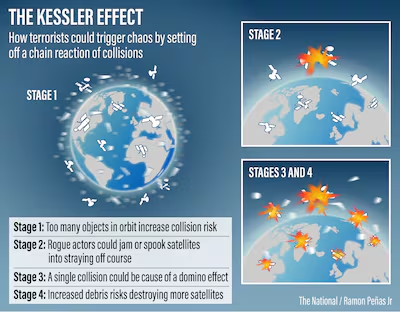A network of Australian observatories has successfully received laser signals from a German satellite in low Earth orbit, paving the way for much faster communication speeds from space.
The University of Western Australia’s three TeraNet observatories – one of which is mobile and mounted on the back of a lorry – use lasers to transfer data between satellites in space and users on Earth, instead of traditional radio signals.
Radio signals have been used to communicate from space since the launch of the first satellite, Sputnik 1, nearly 70 years ago.
But as the number of satellites in space has grown, with each capable of generating more data, there is now a critical bottleneck in sending data back to Earth.
Lasers can help solve that problem. Because they operate at much higher frequencies than radio waves, they can transfer data at thousands of gigabits per second, meaning they pack more information into every second – paving the way for a 1,000-fold increase in communication bandwidth between space and Earth.
“This demonstration is the critical first step in establishing a next-generation space communications network across Western Australia. The next steps include joining this network to other optical ground stations currently being developed in Australia and across the world,” said associate professor Sascha Schediwy from UWA, who leads the TeraNet team.
Laser communication can offer greater bandwidth but it also has drawbacks, because its signals can be interrupted by cloud and rain.
The TeraNet team has created a workaround by establishing a network of three ground stations across the state of Western Australia, meaning if it is cloudy at one site, the satellite can download its data to another which has clearer skies above.

One of the observatories that received the satellite laser signal is built on the back of a custom-built Jeep, so it can be quickly deployed to sites that need ultra-fast space communications, including communities where traditional communications links have been cut off due to natural disasters.
Experts say high-speed laser communication from space will also improve and secure military communication networks, and bolster secure remote operations for sectors such as autonomous mining operations, as well as national disaster planning and responses.
TeraNet will support numerous international space missions operating between low Earth orbit and the Moon, using proven conventional optical communications standards and more advanced optical technology.
The network comprises one ground station at UWA in Perth, another at the Mingenew Space Precinct 300km north of Perth and a mobile hub that is being commissioned at the European Space Agency’s New Norcia site.

Kessler effect
In the late 1970s, during the space race between the United States and the USSR, when an increasing number of satellites were being sent into orbit, scientist Don Kessler warned that the amount of space junk could become so great that collisions would become inevitable.
A chain reaction would be created, causing even more collisions, making it impossible to navigate any spacecraft or equipment, he said. At the time, he estimated the scenario, known as the Kessler effect, would take three or four decades to become a reality.
Space defence experts now fear the possibility of rogue states or groups causing worldwide chaos by using such a scenario to bring down hundreds of satellites.

There are around 2,666 satellites orbiting the Earth, with thousands more tiny bits of debris that could trigger a catastrophic collision.
Currently one satellite a year is destroyed in collisions with space junk, with a one-kilogram piece of debris having the mass to destroy a spacecraft. In Kessler's theory the fragments from this could then hit other satellites with the resulting cascade of disintegration causing massive destruction.
Experts have suggested one solution may be to recycle space debris, using parts and material from decommissioned satellites and debris into useful materials to support other space missions.





